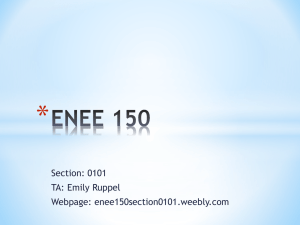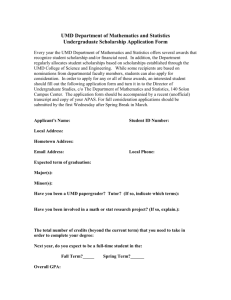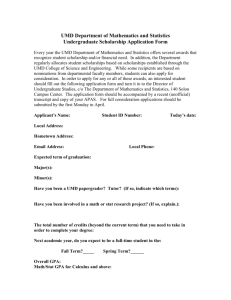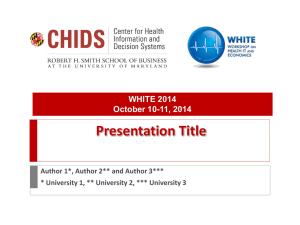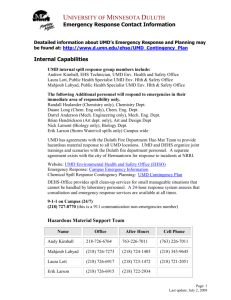Biomolecular Nuclear Magnetic Resonance (NMR) Facility
advertisement
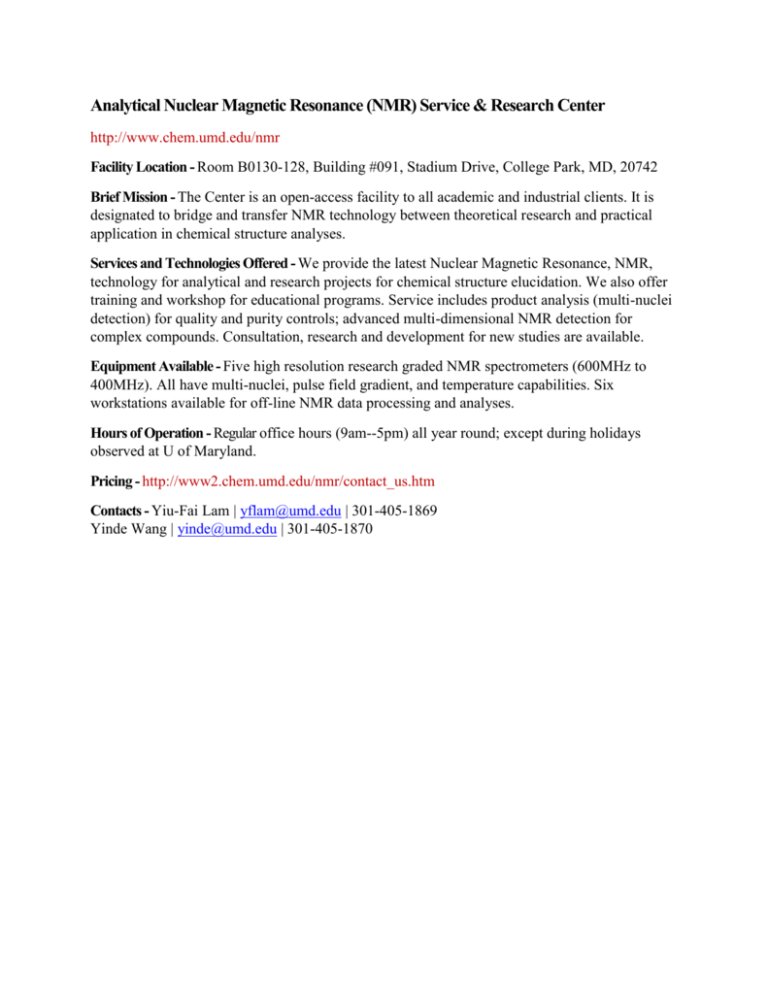
Analytical Nuclear Magnetic Resonance (NMR) Service & Research Center http://www.chem.umd.edu/nmr Facility Location - Room B0130-128, Building #091, Stadium Drive, College Park, MD, 20742 Brief Mission - The Center is an open-access facility to all academic and industrial clients. It is designated to bridge and transfer NMR technology between theoretical research and practical application in chemical structure analyses. Services and Technologies Offered - We provide the latest Nuclear Magnetic Resonance, NMR, technology for analytical and research projects for chemical structure elucidation. We also offer training and workshop for educational programs. Service includes product analysis (multi-nuclei detection) for quality and purity controls; advanced multi-dimensional NMR detection for complex compounds. Consultation, research and development for new studies are available. Equipment Available - Five high resolution research graded NMR spectrometers (600MHz to 400MHz). All have multi-nuclei, pulse field gradient, and temperature capabilities. Six workstations available for off-line NMR data processing and analyses. Hours of Operation - Regular office hours (9am--5pm) all year round; except during holidays observed at U of Maryland. Pricing - http://www2.chem.umd.edu/nmr/contact_us.htm Contacts - Yiu-Fai Lam | yflam@umd.edu | 301-405-1869 Yinde Wang | yinde@umd.edu | 301-405-1870 Biomolecular Nuclear Magnetic Resonance (NMR) Facility http://chem.umd.edu/bionmr Facility Location - Biomolecular Science Building, #296, room 1105 Brief Mission - The facility provides high field NMR (nuclear magnetic resonance) instrumentation to support the UMCP research community through measurements of biomolecules, macromolecules and systems of biological interest. The facility provides advanced training opportunities for students and acts as a hub for interdisciplinary collaborations. The facility also provides NMR analysis services for internal and external users. Services and Technologies Offered We provide state-of-the-art high field NMR instrumentation for structure determination and dynamic studies of biochemical, biological and macromolecular systems. We provide advanced instruction and workshops on high-field NMR measurements and data interpretation. We offer consulting services on sample isotope labeling, sampling methods, and multidimensional NMR methods including various 2D and 3D experiments. We offer analytical services to characterize chemical structures and reactions, intermolecular interactions, physical properties such as diffusion constant and affinity. The facility can analyze a wide range of samples by NMR, from small organic molecules, polymers that require high temperature NMR analysis, to macromoleculars such as proteins and nucleic acids. Equipment Available Bruker AVIII 600 MHz NMR spectrometer equipped with a Cryo-TCI probe Bruker AVIII 600 MHz NMR spectrometer equipped with a TXI probe Bruker AVIII-HD 800 MHz NMR spectrometer equipped with a Cryo-QCI probe Hours of Operation - 24/7 Pricing 800MHz spectrometer: $8/hour for internal users, $60/h for external users 600 MHz spectrometers: $3.5/hour, minimum booking time 24 hours, $ 40/h for external users Contact - Daoning Zhang | zdn3023@umd.edu | 301-405-8239 Biotechnology Scale-Up Facility (BSF) http://www.mtech.umd.edu/biotech/bsf.html Facility Location - 1203 Chem/Nuc. Bldg. #090, University of Maryland, College Park, MD 20742 Brief Mission - The Bioprocess Scale-Up Facility (BSF) is the Biotechnology Research and Education Program's modern bioprocessing laboratory dedicated to the development and scaleup of biotechnology products and processes. With over 1000 fermentations conducted since 1998 alone, the BSF has accelerated the R&D of local biotechnology leaders such as Human Genome Sciences, NIH and MedImmune, as well as growing Maryland start-ups such as Martek Biosciences and Digene Corporation. Services and Technologies Offered The BSF's capabilities include: Fermentation Cell culture Stem cell growth Separations Purification Concentration Product analysis Challenging problems such as biopolymers, turbulence and multiphase fluid dynamics, biosensors, process analysis and control, and both metabolic and biochemical engineering. Equipment Available BSF Equipment Bioreactors from 2 to 250 Liters Process centrifuges (fixed angle and continuous) Cell disruption, Microfluidizer Tangential flow filtration (UF/DF) Chromatography Freeze drying Hours of Operation - Generally 9-5 (hours vary depending on projects) Pricing - Pricing varies by project size and duration. Please contact for more information. Contact - Ben Woodard | woodard@umd.edu | 301-405-3909 Center for Innovative Biomedical Resources (CIBR) http://medschool.umaryland.edu/CIBR/ Facility Location - University of Maryland School of Medicine, 655 W. Baltimore Street, Baltimore MD 21201 Brief Mission - In November, 2013, the University of Maryland School of Medicine launched (dedicated) the Center for Innovative Biomedical Resources (CIBR), the administrative home for the UMSOM biomedical core resources. CIBR serve(s) as a center of excellence for state-of-theart technologies, high-tech instrumentation, and expertise that supports biomedical research, clinical practice and health care in the state of Maryland and the region. Renovation of nearly 30,000 square feet of space was accomplished with $7.3 M in funding from an NIH grant (1G20RR030969, Reece, PI), made possible through the American Recovery and Reinvestment Act. Newly renovated space allows physical consolidation of many core facilities in common space, creating a dynamic environment that will enhance and stimulate high impact research through a trans-disciplinary approach. New facilities give faculty greater access to sophisticated instrumentation, as well as highly-trained technical staff who can offer support to faculty on experimental design, data analysis and interpretation, and provide training opportunities for graduate and medical students, postdoctoral fellows, and faculty within the University and its collaborators. Services and Technologies Offered - http://medschool.umaryland.edu/CIBR/categories.asp Contacts - Nicholas Ambulos | nambulos@som.umaryland.edu | 410-706-8553 Josephine Frazier | jfrazier@som.umaryland.edu | 410-706-1240 Clarice Smith Performing Arts Center http://claricesmithcenter.umd.edu Facility Location - University Blvd. and Stadium Drive Brief Mission - The Center's mission is to transform lives through sustained engagement with the arts. The Center accomplishes this mission through support to the School of Music, the School of Theatre, Dance, and Performance Studies, the presentation of visiting artists from around the world, and collaborative projects with academic programs and community organizations. We are known for forward-looking and risk-taking artistic programming. Services and Technologies Offered - The Center houses six well-equipped theatres and associated production shops that have up-to-date theatrical technologies in audio, lighting, video, and costume and set production. Within the School of Music and the School of Theatre, Dance, and Performance Studies, there are design and rehearsal studios that are core teaching spaces. The Michelle Smith Performing Arts Library has current electronic access to music, theatre, and dance materials, as well as printed materials in all three disciplines. Equipment Available - Equipment lists for the theatres is on the website listed below. Hours of Operation - Sunday through Saturday, 7:00am-11:00pm Pricing - http://claricesmithcenter.umd.edu/our-facilities Contacts – Martin Wollesen | wollesen@umd.edu | 301-405-2993 Kimberly Moore Turner | kimturner@umd.edu | 301-405-2993 Genomics Core http://cbmg.umd.edu/resources/corefacilities/genomicscore Facility Location - Genomics Core, 2229 Bioscience Research Building, College Park, MD 20742 Brief Mission - Established by the Department of Cell Biology and Molecular Genetics, the Genomics Core provides faculty and students with a centralized resource where users have the opportunity to access automated nucleic acid sequencing and analysis instrumentation, as well as Real-Time PCR (qPCR) technology. Services and Technologies Offered - The Genomics Core provides researchers with the opportunity to access a 3730xl DNA sequencer (Sanger sequencing) and two Real-Time PCR machines. Services include training on all equipment. Services do not include sample preparation. Equipment Available 3730xl DNA sequencer: Sanger sequencer with a 96-capillary array allows researchers to perform high-throughput, large-scale nucleic acid sequencing and fragment analysis. Roche LightCycler 480 Real-Time PCR machine: Standard qPCR machine that can run 96 and 384 well plates. Bio-Rad CFX96 Real-Time PCR machine: Standard qPCR machine that can run 96 well plates. Hours of Operation - Fully trained, independent users may access the instrumentation 24 hours a day, 7 days a week. The Director is available to assist and train users from 8am-4:30pm Monday through Friday. Pricing - http://cbmg.umd.edu/files/cbmg/corelab/20122013%20Genomics%20Core%20Rates.pdf Contact – Dr. Yan Wang | yangwang@umd.edu | 301-405-6764 Glenn L. Martin Wind Tunnel http://www.glmwt.umd.edu Facility Location - Wind Tunnel Building, Building 081, Paint Branch Drive Brief Mission - The mission of the GLM Wind Tunnel includes the following. The GLMWT team works to advance the level of aerodynamic design of vehicles and other devices by generating appropriate design and development test data. We advance the state of the art in aerodynamics, fluid mechanics, and closely related disciplines experimental research. We advance the state of the art in tunnel testing methods including modeling arrangements, instrumentation, and increasing the integration of computational capabilities for rapid data presentation and rapid comparison of results of measurements, analyses, and computational simulations. We contribute to the education of undergraduates and graduate students by engaging them in our laboratory work, and by providing our capabilities to support their research projects. We provide research and development expertise, service, and education to citizens of the area, state, and nation by being available to companies and government agencies, by hosting visitors and engaging in other activities to enhance and broaden the understanding of the influence of aerodynamics in various human activities. Services and Technologies Offered - The GLMWT provides service to support all aspects of experimental aerodynamics. A user can engage the GLMWT staff to plan experiments to achieve a specified set objectives, design any hardware and software needed, carry out the experiment to acquire the data, and prepare a resulting test report for the user. More experienced users can conduct any of the necessary preparations with whatever level of consultation with the GLMWT staff is needed, bring the test article to the GLMWT and have the support of the GLMWT staff in conduct of the experiment. In many cases the data is provided to experienced users as the test progresses and the user then prepares the post-test reports. In addition to supporting all aspects of aerodynamic experiments, the GLMWT can arrange for computational simulations to assist in the planning of experiments and the assessment of experimental results. Equipment Available - The primary equipment is the Glenn L. Martin Wind Tunnel. The GLMWT is a closed loop solid wall wind tunnel. The test section is 7'9" high, 11' wide, and 13' long. The maximum speed is 230 mph with upgrades in planning to bring the maximum speed to 330 mph. Primary instrumentation provides capability to measure six component forces on test articles ranging from aircraft to ground vehicles, marine vehicles, building components, etc. Instrumentation includes pressure transducers, temperature transducers, flow visualization equipment, and specialized software for experiment automation, data gathering, and data presentation. Hours of Operation - Standard operating hours are 7:30 am to 4:30 pm Monday through Friday with additional hours frequently provided when demand is high and/or schedules require. Pricing - Current charge is $950.00 per occupancy hour for time in the GLMWT. Engineering consultation, shop services for fabrication and modification, and research assistance is available at competitive rates. Contacts - Jewel Barlow | barlow@umd.edu | 240-464-3871 Ahmad Kassaee | kassaee@umd.edu | 301-405-6861 Herschel S. Horowitz Center for Health Literacy http://www.healthliteracy.umd.edu Facility Location - The Center is part of the Dean’s Office of the School of Public Health, University of Maryland College Park, MD Brief Mission - The Center advances research in health literacy and health communication and translates that research into education and community action that improves health outcomes for all. Services and Technologies Offered - The Center conducts multi-methodological, interdisciplinary research projects, partnering with academic colleagues, community organizations and government agencies. Faculty also consult and train on health literacy, plain (clear) language and cultural competency. Faculty teach courses in health communication and health literacy, and assist with curriculum in health literacy. Faculty conduct qualitative research, focus groups, interviewing, as well as experimental design and survey methodology. Hours of Operation - 9 am to 5 pm Monday through Friday Pricing - Pricing based on project scope and staff need. Contact – Sarah D. Radice | sradice@umd.edu | 301-405-2356 Imaging Core http://cbmg.umd.edu/resources/imaging-core Facility Location - 0107 Microbiology Building, College Park, MD 20742 Brief Mission - Established in the year 2000 by the Department of Cell Biology and Molecular Genetics, the Imaging Core was designed to enhance research and education at the University by providing students and faculty with access to sophisticated light microscopes and imaging instrumentation whose purchase and maintenance costs far exceed the budgets of individual investigators. Serving as the primary resource for advanced light microscopy in the Biological Sciences at the University of Maryland, the mission of the facility is to enhance research and education by: Providing access to state-of-the‐art light microscopy and imaging instrumentation, Offering detailed training opportunities and support in basic and advanced light microscopy techniques and, Keeping researchers up to date with the latest technology and innovations in light microscopy. Services and Technologies Offered - The Imaging Core provides researchers with the opportunity to image live, fixed, unlabeled or fluorescently labeled samples using one of several available microscopes, including a Zeiss LSM710 confocal, a Leica SP5X confocal, and an Axiophot Fluorescence microscope. Services include training on all equipment, guidance on experimental design and Director-assisted microscope operation. Equipment Available - Zeiss LSM710 Confocal microscope: This inverted microscope is equipped with the following lasers: 405 diode, Argon (458, 488, 514), 561 and 633 lasers. Objective lenses include 10x dry, 40x oil, 63x oil, 100x oil, 63x water. It has 3 spectral detectors plus a transmitted light PMT. Leica SP5X Confocal microscope: This inverted microscope is equipped with the following lasers: 405 diode, Argon (458, 488, 514), white light laser (470-670nm in 1nm increments). Objective lenses include 10x dry, 20x multi-immersion, 40x oil, 63x oil, 63x water, 63x glycerol. It has 5 spectral detectors plus a transmitted light PMT. It has a motorized x-y stage, galvo-z stage, resonant scanner and environmental chamber. Zeiss Axiophot: is an upright fluorescence microscope with standard DAPI, FITC, TRITC filters and digital camera. Hours of Operation - Fully trained, independent users may access the instrumentation 24 hours a day, 7 days a week. The Director is available to assist and train users from 8am-4:30pm Monday through Friday. Pricing - http://cbmg.umd.edu/files/cbmg/corelab/2012-2013%20Imaging%20Core%20Rates.pdf Contact - Amy Beaven | abeaven@umd.edu | 301-405-7238 Charles Delwiche | delwiche@umd.edu | 301-405-8286 Maryland Fire and Rescue Institute (MFRI) http://www.mfri.org/ Facility Location - Maryland Fire and Rescue Institute 4500 Paint Branch Parkway College Park MD 20742 Contact – Steven Edwards | director@mfri.org | 301-226-9960 Maryland NanoCenter http://www.nanocenter.umd.edu/ Facility Location - 1119 Jeong H. Kim Engineering Building Brief Mission - The Maryland NanoCenter is the hub of a network of interdisciplinary researchers, faculty, labs, and organizations with the goal of advancing the knowledge and understanding of all things nano. We strive to deliver high quality tools, advice and service to the entire midAtlantic region research community and beyond. Services and Technologies Offered FabLab NISPLab NanoOptics Lab Equipment Available - http://www.nanocenter.umd.edu/equipment/ Hours of Operation - 7:00 – 5:30 M-F, excluding University holidays; UMCP users only: 24/7 access with staff permission Contact – Gary Rubloff | rubloff@umd.edu | 301-405-3011 Maryland NanoCenter: Micro & Nano Fabrication Laboratory (FabLab) http://www.nanocenter.umd.edu/labs/FabLab/ Facility Location - 2302 Jeong H. Kim Engineering Building Brief Mission - The Maryland NanoCenter is the hub of a network of interdisciplinary researchers, faculty, labs, and organizations with the goal of advancing the knowledge and understanding of all things nano. We strive to deliver high quality tools, advice and service to the entire midAtlantic region research community and beyond. Services and Technologies Offered - A professionally staffed, full-service micro and nano processing center supporting nano materials, electronics, optics, sensors and microelectromechanical systems (MEMs) research and development. Equipment Available - http://www.nanocenter.umd.edu/labs/FabLab/equipment/ Hours of Operation - 7:00 – 5:30 M-F, excluding University holidays; UMCP users only: 24/7 access with staff permission Pricing - http://www.nanocenter.umd.edu/labs/FabLab/fees.php Contact – Jim O’Connor | joconnor@umd.edu | 301-405-5018 Maryland NanoCenter: NanoOptics Lab http://www.nanocenter.umd.edu/nanoopticslab/ Facility Location - 0202A Energy Research Facility (We are located first floor of the Energy Research Facility Building #223, also known as the IREAP building) Brief Mission - The Maryland NanoCenter is the hub of a network of interdisciplinary researchers, faculty, labs, and organizations with the goal of advancing the knowledge and understanding of all things nano. We strive to deliver high quality tools, advice and service to the entire midAtlantic region research community and beyond. Services and Technologies Offered - Our newest lab, the NanoOptics Lab is dedicated to optical metrology of materials and devices. Our tools include an FTIR spectrometer and a Horiba UVVis imaging spectrometer. Our NT-MDT NTEGRA Spectra Scanning Probe Microscope is configured for confocal Raman capability. In addition to standard materials, the NT system can handle wet, electrochemical, and biological samples. Equipment Available - http://www.nanocenter.umd.edu/nanoopticslab/ Hours of Operation - Currently by appointment only. Pricing - http://www.nanocenter.umd.edu/nanoopticslab/fees/ Contact – Jim O’Connor | joconnor@umd.edu | 301-405-6173 Maryland NanoCenter: Nanoscale Imaging Spectroscopy & Properties Laboratory (AIMLab) http://www.nanocenter.umd.edu/aimlab Facility Location - 1237 Jeong H. Kim Engineering Building Brief Mission - The Maryland NanoCenter is the hub of a network of interdisciplinary researchers, faculty, labs, and organizations with the goal of advancing the knowledge and understanding of all things nano. We strive to deliver high quality tools, advice and service to the entire midAtlantic region research community and beyond. Services and Technologies Offered - NISPLab is dedicated to the characterization of the structure and composition of a broad spectrum of hard and soft materials and biological systems with nanometer resolution. These capabilities are used for research, and the teaching and training of students. The research performed in the laboratory is focused on the characterization of materials and structures in the areas of biomaterials, multifunctional and smart materials, nanostructured materials, nanodevices and geological materials. Equipment Available - http://www.nanocenter.umd.edu/labs/NISP/facilities.php Hours of Operation - 7:00 – 5:30 M-F, excluding University holidays; UMCP users only: 24/7 access with staff permission Pricing - http://www.nanocenter.umd.edu/labs/NISP/policies.php Contact – Wen-An Chiou | wachiou@umd.edu | 301-405-0541 Maryland Neuroimaging Center http://www.mnc.umd.edu Facility Location - 8077 Greenmead Drive, Building #795, College Park, MD 20742 Brief Mission - The Maryland Neuroimaging Center (MNC) is the home for neuroimaging research at the University of Maryland. Housed in a spacious new facility in the Gudelsky Building, adjacent to the main College Park campus, the center has been designed to foster collaboration among neuroscientists, psychologists, cognitive scientists, engineers, and physicists. A special focus of the center is on understanding mechanisms of brain development and neural plasticity in typical and atypical populations, and in understanding the neural mechanisms underlying expert abilities that serve critical national priorities. The MNC is an initiative of the university's interdepartmental Neuroscience and Cognitive Science (NACS) Program.It is available to researchers from UMD and other regional centers. MNC houses a research-dedicated Magnetic Resonance Imaging (MRI) scanner, ideal for mapping brain structures and the location of brain activity. Future plans for the center will bring together an array of state-of-the-art tools for observing the human brain in action including: Magnetoencephalography(MEG) and Electroencephalography (EEG) facilities, which offer millisecond-level information about the time-course of neural activity. Services and Technologies Offered - MRI scans, MRI data analysis. Equipment Available - The centerpiece of the facility is a state-of-the-art Siemens 3 Tesla TIM TRIO scanner, equipped with 32 receive channels for significant increases in signal-to-noise and acquisition speed. Mock Scanner: Our MRI simulator looks, feels, and sounds like the real thing. It is especially useful for preparing special populations, such as pediatric participants, for their experience in the real scanner, making data acquisition more successful. Data Analysis Lab Functional MRI Stimulation and Response Recording System SRA Eye Tracker Hours of Operation - Open Monday - Friday and two Saturdays a month for scanning. Pricing - Please see our website: www.mnc.umd.edu for more information Contacts – Luiz Pessoa | pessoa.mri@gmail.com | 301-405-2423 Sandy Collier | collier@umd.edu | 301-405-4125 Mass Spectrometry Facility http://www.chem.umd.edu/sharedinstrumentation/massspectrometryfacility Facility Location - Mass Spectrometry Facility, Department of Chemistry and Biochemistry, Building 091, room 0511, University of Maryland, College Park, MD 20742 Brief Mission - The Mass Spectrometry Facility supports basic research efforts throughout the University of Maryland. The facility offers training for independent operation of instruments as well as sample analysis by facility personnel. The facility’s services are also open to external academic institutions and industry. Services and Technologies Offered - Mass spectrometric analysis of gaseous, liquid and solid samples. The following methods/services are available in the facility: GC-EI/CI FAB-direct probe HPLC-ESI/APCI MALDI DART(direct analysis in real time) Equipment Available GC-MS: Agilent 6890N coupled with JEOL MStation HPLC-ESI-MS: Agilent 1100 HPLC system coupled with JEOL AccuTOF Shimadzu Axima-CFR MALDI-TOF Hours of Operation - Monday to Friday, 8:00am-5:00pm Pricing User Operated Staff Operated UMD – Chemistry $20/hr $60/hr (1 hour minimum) UMD – Others $30/hr $90/hr (1 hour minimum) External Users N/A $120/sample Contact – Yue Li | yueli@umd.edu | 301-405-1871 Michelle Smith Collaboratory for Visual Culture http://michellesmithcollaboratory.umd.edu/ Facility Location - 4213 Art/Sociology Building, University of Maryland, College Park 20742 Brief Mission - A center for visualization and collaboration, the Collaboratory is distinguished by a large, curved projection wall in an intimate, inviting space. The Collaboratory was intended from the start to be a dynamic arena in which scholarly collaboration and interdisciplinarity unfolded in tandem with the Department of Art History and Archaeology’s strategic goal to be a leader in the field of visual studies, broadly defined. A flexible, well-equipped, and expertly staffed facility—one that can ably function as a classroom, conference center, meeting room, and laboratory—the Collaboratory constantly exercises and refines its potential as a center for creative and pioneering innovation. The Collaboratory allows both faculty and students to discover and implement resources in the digital humanities that, in turn, foster new scholarship and new knowledge. The Collaboratory has become an important resource for faculty and students in art history as well as in other disciplines throughout the College of Arts and Humanities and the university. Services and Technologies Offered - The Collaboratory has a large visualization space that sets it apart from most labs/resources at the University of Maryland. A large, slightly-curved projection wall (22' x 7 1/2') anchors one end of an intimate, inviting and flexible space that can seat up to 35 comfortably, 40-45 less so. This space has been used for classes, lectures, small conferences, receptions, and as a technology laboratory wherein students/researchers might test drive new equipment or ideas. Project consultation and guidance for an array of research and teaching needs is a strength of personnel within the Collaboratory, with particular expertise in: image manipulation (Photoshop); three-dimensional modelling (principally Sketchup); visual database manipulation (especially Google Earth, but a growing number of approaches for visualizing humanitiescentered data sets); teaching tools (exploiting PowerPoint, Prezi, et al. for maximum results). Equipment Available The aforementioned projection space features a Dell Precision T7400, 16 GB RAM computer (OS XP, 7, 8) that, along with a NVIDIA Quadroplex 2200 D2 graphics array, feeds two Panasonic PT-DZ6710 projectors that result in a wall-dissolving continuous image. 5.1 surround sound speakers and a third projector cabled in to: Blu-Ray, VHS, auxiliary inputs (laptops, ipads et al) complete the technical features of this space. A back workroom features 4 Dell computers, two of which are attached to 11" x 17" flatbed scanners and one slide scanner. Some limited video editing equipment (VHS and DVD players to digital capture) is available. Hours of Operation - 8:30 AM -- 4:30 PM, Monday through Friday Pricing - Pricing to be determined on the basis of specific project costs Contacts - Quint Gregory | quint@umd.edu | 301-405-3183 Nicole Riesenberger | nriesenb@umd.edu | 301-405-1479 Neutral Buoyancy Research Facility (NBRF) http://www.eng.umd.edu/facilities/nbrf Brief Mission - The NBRF is one of two currently operating neutral buoyancy tanks in the US. It is the only one in the world located on a college campus, and the only one dedicated to basic research. Neutral buoyancy is one of the primary means of simulating the microgravity environment of space; while the NBRF was originally developed to support NASA studies of orbital operations, it is also actively used for underwater robotics and both human and robotic operations in simulated lunar and Mars gravity. Related research in the Space Systems Laboratory (SSL) emphasizes space, undersea, and medical rehabilitation robotics; space human factors, including bioinstrumentation and advanced space suit design and testing; human-robot collaboration technologies; and the underlying fundamentals of space simulation. Services and Technologies Offered - The neutral buoyancy tank is 50 feet across, 25 feet deep, and holds 367,000 gallons of water. Water temperature is maintained at 88°F for consistency of buoyancy and comfort of test support divers, and is specially filtered for maximum visual clarity. The facility allows external access for underwater test hardware up to 15 feet on a side and up to 4000 pounds in weight. Complete SCUBA diver support facilities include two locker rooms, air compressors for filling SCUBA bottles, and both underwater speakers and bidirectional underwater communications system. A secure storage facility for underwater test hardware is located outside the NBRF for hardware which will not be damaged by exposure to the elements. There are currently six robots operational in the NBRF, including two generations of Ranger, a four-armed satellite repair robot; two SCAMP vehicles and EUCLID, all 6 degree of freedom free-flying underwater vehicles used as camera platforms and for advanced control algorithm development; and SAMURAI, a 6000-meter rated deep ocean electrical dexterous manipulator for autonomous underwater operations. The NBRF is equipped with a 12-camera Qualisys motion tracking system capable of providing measurement of the location and velocity of an essentially unlimited number of optical targets at submillimeter accuracy and less than 100 msec sample times. The robotic manipulator systems are also capable of operation in the laboratory environment, allowing simplified checkout and correlation between underwater and laboratory simulations. The SSL has developed two series of human-rated suits for simulation of extravehicular activity underwater. The MX-2 system is a full pressure suit, operating at 3.5 psid and providing a dry environment for the wearer with high fidelity to flight-rated pressure suits. This suit has been equipped with a variety of bioinstrumentation for measuring body motions and metabolic workload, as well as advanced controls and displays for immersive virtual reality presentations as part of the underwater simulation. A parallel series of space suit simulators provide a lowerfidelity experience of suited operations, but provide low-cost simulations without excessive training requirements for the test subject. Wearers of the MX-C/MX-D series of suit simulators are immersed in water, and effectively supplied by conventional scuba equipment within the suit envelope. Other human test systems available at the NBRF include a body harness for body segment parameter ballasting for realistic simulation of partial gravity environments such as the moon and Mars, and an underwater treadmill for studying gaits and workloads. A small but very well-equipped machine shop on-site is used to fabricate and repair test equipment, with both manual and computer guided mills and lathes, sheet metal forming capabilities, and TIG welding equipment. The SSL also has access to rapid prototyping capabilities and the well-equipped machine shop of the Clark School of Engineering. The NBRF control room is used for conducting tests in the neutral buoyancy tank. The control room has four general-purpose workstations that are used to control robots underwater through Space Shuttle-style hand controllers or a virtual reality interface, as well as providing multiple user-selectable video views from cameras in and above the tank. A multichannel communications system allows test conductors to talk with divers underwater, with personnel throughout the NBRF, and with other sites across the country through the Internet and satellite links. The control room also houses a complete video control and editing suite, and is capable of sourcing live video feeds for broadcast purposes. Equipment Available 50 ft. diameter x 25 ft. deep neutral buoyancy water tank Standard diving equipment: regulators with octopus and buoyancy control devices AGA full-face masks for two-way communication 25 ft. hookah rigs for externally mounted or surface-supplied air Underwater handling equipment (lift bags and rigging straps) 2-ton overhead wirelessly controlled hoist Diver locker rooms, scuba prep area, water ingress/egress platform 12 wall-mounted hard points for securing test hardware Two underwater remote pan/tilt/zoom cameras controllable via internet Numerous underwater video cameras with live feeds High resolution underwater still and video cameras for documentation 32x32 video crosspoint switching system Video recording in Betamax, VHS, Hi-8, digital tape, and direct-to-media digital stream 24-channel audio mixing board 12-channel audio intercom system Wired and wireless audio belt packs 12-camera Qualisys underwater motion tracking system Three Ranger NBV dexterous robot arms (6-7 DOF x 1.5 m length) Two Ranger TSX dexterous robot arms (10 DOF x 1.5-4 m length) Ranger PXL positioning manipulator (6 DOF x 2.5-10 m length) SAMURAI 6000 meter depth-rated manipulator (6 DOF x 1.25 m length) Two SCAMP free-flying camera platforms EUCLID free-flying space simulation vehicle MX-3 pressurized space suit (under development) Two MX-C space suit simulators MX-D hard-suit space suit simulator (under development) Video/audio control, routing, recording, and broadcast station Four software-configurable general purpose robot control stations Conference and test monitoring room Machine shop Hours of Operation - M-F 9:00am to 4:30pm; alternate times by arrangement. The NBRF has the capability to conduct night tests (no ambient lighting) if required. Pricing - Basic facility rental is $2500/day, which includes Space Systems Laboratory personnel supporting surface activities and conducting underwater test support. Dive personnel from outside entities can be certified to dive in support of test operations, but this requires extensive training and certification as well as physician health exams. Organizations interested in supplying dive personnel should contact the NBRF no less than two months prior to testing. Contact – David Akin | dakin@ssl.umd.edu | 301-405-1138 Proteomics Core Facility http://cbmg.umd.edu/resources/corefacilities/proteomicscore Facility Location - Proteomics Core Facility, Rm 0109/0111 Biology Psychology Building, College Park, MD 20742 Brief Mission - The mission of the Proteomics Core Facility is to enhance research in life sciences by bringing high-end instrumentation and expertise in proteomics research. The Facility is equipped with state-of-art LTQ Orbitrap XL mass spectrometer that’s interfaced to a 2D nano HPLC system to provide the best sensitivity and accuracy for protein and peptide analysis. A full suite of software packages are maintained up-to-date to provide informatics support. The Facility provides service and collaboration to the entire research community with priority given to College of Computer, Mathematics, and Natural Sciences Faculty. While the main focus of the Facility is proteomics analysis, the equipment and personal is capable of performing analysis for most biomolecules. The Facility Director, Dr. Yan Wang, has over 15 years of experience working with a variety of mass spectrometry systems, focusing on proteomics. Dr. Wang attends national conferences yearly to stay up-to-date with current research and technology, and to present work going on in the Facility for discussion with peers. Services and Technologies Offered LCMS analysis of intact proteins LCMSMS analysis of proteolysis products, data base searching, data interpretation Peptide fractionation of samples with high complexity Characterization of protein post-translational modifications Consultation in experimental design and sample preparation Support for grant preparation Equipment Available Thermo Electron LTQ Orbitrap XL mass spectrometer with ETD Shimadzu 2D nano HPLC system (only to be used with the mass spectrometer) Agilent 3100 OFFGEL fractionator (solution phase isoelectric focusing) Proteomics Bioinformatics workstations, software packages include Proteome Discoverer, Scaffold, Sieve, Mascot Server, and Prosight PC. All packages are updated to the newest release and will be updated when new releases become available. Hours of Operation - Monday - Friday 9 am - 4 pm; Appointment preferred, walk in accommodated with best effort. Pricing - http://cmns-corefacilities.umd.edu/sites/default/pdf/Proteomics-Fees_Feb2009.pdf Contact – Yan Wang | yanwang@umd.edu | 301-405-6764 (office), 301-405-8425 (lab) Sequencing Core http://www.ibbr.umd.edu/facilities/sequencing Facility Location - 5129 Plant Sciences Building Brief Mission - The UM-IBBR Sequencing Core provides the research community at the University of Maryland (as well as off-campus customers) with access to 'Next Generation' sequencing. We feature an Illumina HiSeq1000 instrument, which can generate up to 500 million clusters, or a billion paired-end reads per run. Services and Technologies Offered - Illumina: Run times range from about four days for 50-base applications to 8 days for 100-base paired-end reads and the accuracy enables a broad range of applications, including but not limited to: DNA sequencing (DNA-seq) Transcriptome analysis (RNA-seq) Information about the Illumina technology and capabilities can be viewed at www.illumina.com. Equipment Available - Illumina HiSeq1000 Applied Biosystems DNA sequencer (model 3730) Hours of Operation - 9 AM-5 PM Monday-Friday Pricing - http://www.ibbr.umd.edu/facilities/sequencing/illumina/pricing Contact - Suwei Zhao | suezhao@umd.edu | 301-405-5222 Shady Grove Biopharmaceutical Advancement Facility (BAF) http://www.mtech.umd.edu/biotech/baf.html Facility Location - Institute of Bioscience and Biotechnology Research, 9600 Gudelsky Drive, Rockville, MD 20850 Brief Mission - The Biopharmaceutical Advancement Facility (BAF) is a translational core facility located at IBBR Shady Grove that specializes in the development of cell culture-based biopharmaceutical products. BAF is part of the Biotechnology Research and Education Program of the University of Maryland’s Technology Enterprise Institute (MTECH). The BAF is closely aligned with the Bioprocess Scale-Up Facility located in College Park. The facility's staff members offer extensive expertise in addressing challenging problems with the advancement of anchorage-dependent or suspension-adapted cell lines. The facility is not restricted by current good manufacturing practices (cGMPs); however, production processes are directly transferable to partners operating under cGMPs. The facility offers quick turnaround and flexible contracting arrangements that can include specialized training or working with our staff in the facility. Services and Technologies Offered • Companies developing cell culture-based biopharmaceuticals or products • Researchers looking for solutions to cell culture-based development challenges • Faculty needing a facility for, or expertise in, biopharmaceutical or cell culture-based research Equipment Available Process Equipment • Static and shaking incubators • New Brunswick Scientific (NBS) Celligen 310 Bioreactors (working volume of 1.5, 2.5, 5.0, and 10.0 liters) • Hollow Fiber and Tangential Flow Filtration Systems Pricing - Please contact us for pricing of available services Contact - John Kerwin | jkerwin@umd.edu | 240-314-6157 Surface Analysis Center http://www.chem.umd.edu/sharedinstrumentation/surface-analysis-center/ Facility Location - B0127, Chemistry Building 091 Brief Mission - The surface analysis center houses state-of-the-art instrumentation and provides services for surface analysis including X-ray photoelectron spectroscopy (XPS), confocal Raman and atomic force microscopy (AFM). The facility is staffed by experts and is managed on a feeper-service basis. The facility is open to academic, government and, industrial users. Services and Technologies Offered - Generally users are trained on the Raman and AFM, after training the user is able to reserve the instrument through an online booking system, and use the instruments unsupervised. XPS samples are generally run by the center staff, users would normally drop off samples and pick up analyzed data. Equipment Available XPS Kratos Axis 165 Photoelectron Spectrometer, with Al monochromatic x-rays as well as a dual Al/Mg source, Argon iron sputtering, heating and cooling stage, charge neutralization and mapping capabilities. Confocal Raman Horiba Jobin Yvon - Labram Aramis, equipped with swift and duoscan mapping options as well as stage mapping allowing rapid collection of mapping with the highest possible resolution. AFM Digital instruments, Multimode, Nanoscope III, with phase imaging capabilities and fluid cells for liquid AFM. Hours of Operation - Normal hours of operation are 9:00 - 5:00 PM Monday to Friday. Trained users with University ID's are able to activate their ID's to gain access to their run samples on the AFM and Raman instruments after hours and weekends. Pricing - http://www.chem.umd.edu/sharedinstrumentation/surface-analysis-center/ Contact - Karen Gaskell | kgaskell@umd.edu | 301-405-4999 Test Services and Failure Analysis Laboratory http://www.calce.umd.edu/TSFA Facility Location - CALCE Center for Advanced Life Cycle Engineering, 1103 Engineering Lab Building, University of Maryland, College Park, MD 20742 Brief Mission - The Test Services and Failure Analysis Laboratory at CALCE provides the most efficient and cost effective analytical services, failure analysis, design reviews, reliability audits, warranty cost analysis, testing and reliability assessment assistance to all interested parties. The TSFA Lab performs standard and custom tests and failure analysis services, including proprietary services that may range from a day to several years. Services and Technologies Offered Real time x-ray Environmental SEM (ESEM) Secondary battery test capability Vibration testing (single axis, 6 DoF, Highly Accelerated Life Test HALT) Scanning Acoustic Microscopy (SAM or CSAM) Differential Scanning Calorimeter (DSC) Thermo-mechanical Analyzer (TMA) X-ray Florescence (XRF) Electro-static Discharge (ESD) simulation Dynamic Materials Analyzer (DMA) Equipment Available Phoenix Real time x-ray system 160 KV Quanta FEG Environmental SEM (ESEM, hot and cold stage) Oxford EDS CADEX 4 channel and ARBIN 16 channel secondary battery testers Vibration testing single axis ED Shaker Qualmark Highly Accelerated Life Test (HALT) OKOS Scanning Acoustic Microscopy (SAM or CSAM) Perkin Elmer Differential Scanning Calorimeter (DSC) Perkin Elmer Thermo-mechanical Analyzer (TMA) Fisherscope X-ray Florescence (XRF) ETS Electro-static Discharge (ESD) simulation Hours of Operation - 7am to 5pm, Monday-Friday Pricing - Please feel free to contact the laboratory staff at services@calce.umd.edu or call (301) 405-5323 (or (301) 405-3498) to request a price quotation. Contact – Bhanu Sood | bpsood@calce.umd.edu | 301-405-3498 The Laboratory for Biological Ultrastructure http://biology.umd.edu/lbu Facility Location - The Laboratory for Biological Ultrastructure, University of Maryland, Department of Biology, Room 0240, College Park, MD 20740 Brief Mission - The mission of the Laboratory is to provide a high quality, well equipped central biological electron imaging facility containing staff and a full complement of equipment for the successful preparation and imaging of a wide variety of biological sample types. The Laboratory will also serve as a training venue for faculty, post-doctoral, graduate and undergraduate students, and outside investigators in the various techniques of biological electron microscopy. Services and Technologies Offered Biological specimen preparation through resin embedding for TEM Biological specimen preparation through critical point drying for SEM Ultramicrotomy of embedded samples (ultrathin & semi-thin sections for TEM) Sample coating via sputtering or vacuum evaporation Transmission electron microscopy (20-100KV) Scanning electron microscopy (conventional) Scanning electron microscopy (field emission) Training in selected techniques Equipment Available Zeiss 10 CA and JEOL 100CXII Transmission Electron Microscopes AMRAY 1820D Scanning Electron Microscope Hitachi S-4700 Field Emission Scanning Electron Microscope with transmitted electron detector EDAX Genesis EDS System for elemental microanalysis of samples (on AMRAY 1820D) Backscattered Electron Detectors on both SEMs Denton DCP-1 Critical Point Dryer Pearse-Edwards Tissue Dryer Reichert (2), LKB (1) and Sorvall ultramicrotomes for conventional thin sectioning Denton Vacuum Evaporators (2) Balzers MED 010 Deposition System Leica AFS Freeze Substitution System Leica KF80 Cryofixation System Nikon Diaphot 300 Inverted Microscope Zeiss Photomicroscope (2) with BF, phase and Nomarski optics Hours of Operation - The hours of operation are Monday through Friday, 8:30 AM until 5:00 PM. Pricing Specimen preparation through microscopy for TEM $ 520.00 Specimen preparation only $ 360.00 Specimen preparation through microscopy for SEM (conv) $ 408.00 Specimen preparation through microscopy for SEM (FE) $ 415.00 Specimen preparation only $ 285.00 Training/Technical assistance $ 50.00/hour Consumable supplies not included in the above procedures are available and are billed at our cost. Contact Tim Maugel | tmaugel@umd.edu | 301-405-6898 The University of Maryland Center for Health Equity http://sph.umd.edu/center/che Facility Location - 3302E SPH Building #255, College Park, MD 20742-2611 Brief Mission - The Maryland Center for Health Equity (M-CHE) establishes and sustains a community engaged research enterprise on critical health disparities, raises the visibility of racial and ethnic health disparities and promising solutions with Marylanders, and facilitates necessary action for changing the structural determinants of health within the state. We envision ourselves as a vibrant contributor to the University of Maryland’s reinvigorated land grant mission by including the elimination of racial and ethnic disparities to achieve health equity Services and Technologies Offered - Established in 2010, the University of Maryland Center for Health Equity (M-CHE) is a university-wide research initiative dedicated to the elimination of racial and ethnic health disparities through community engaged research and increasing the participation of racial and ethnic minority populations in research including clinical trials. We have developed several signature services available to faculty at UMD, UMB and across the University System of Maryland. Services include, but not limited to: A. The Maryland Community Research Advisory Board (MD-CRAB) is a forum that ensures the results of health science research benefit vulnerable populations, especially African Americans and Latinos who suffer from a greater burden of preventable illness and premature death. Composed of 65 individuals representing community opinion leaders, the MD-CRAB convenes monthly from September to May to review research protocols presented by investigators, provide critical reviews of these protocols, and make vital recommendations for culturally tailoring recruitment and retention materials. http://www.healthequity.umd.edu/md_crab.asp B. The Public Health Critical Race Institute The Institute is intended for scholars and researchers interested in learning how to incorporate the principles of Critical Race Theory and Public Health Critical Race Praxis into their research. Participants engage in a variety of interactive and didactic sessions, small group work and a cultural experience that explores race and racism in contemporary America and its impact on the health and welfare of communities of color. http://www.healthequity.umd.edu/events_2013_august5.asp C. The Health Equity Leadership Institute is a week-long research boot-camp conducted in collaboration with the University of Wisconsin, Madison. It is designed to support and advance the career development of underrepresented minority faculty and researchers who are interested in targeting the elimination of health disparities. http://www.healthequity.umd.edu/heli.asp D. Educational Interventions from Building Trust between Minorities and Researchers: A National Bioethics Research Infrastructure Initiative. This intervention was developed to build capacity for respectful engagement and mutual benefit on both sides of the research endeavor, targeting both researchers and potential study participants. Becoming a Self-Reflective Researcher: Successfully Engaging Minority Communities is designed for investigators and is composed of seven ninety-minute modules. Enhancing Minority Engagement in Research is designed for racial and ethnic minority communities and is composed of five ninety-minute modules. For additional information download brochure at the Link below: http://www.healthequity.umd.edu/documents/BT%20Brochure_final_11-19-12.pdf Hours of Operation - 9:00 am to 5:00pm Monday through Friday Pricing - Prices available upon request. Contact - Stephen Thomas | sbt@umd.edu | 301-405-8859 The University of Maryland Prevention Research Center http://www.sph.umd.edu/umdprc/ Facility Location - Rm2302 SPH Building #255, College Park, MD 20742-2611 Brief Mission - To reduce health disparities in Maryland along the national capital border. The national capital border area in Prince George's County, Maryland between the "National Capital Beltway", the District of Columbia, and Montgomery County, Maryland is specifically targeted for community health improvement. Services and Technologies Offered - Established in 2009, the University of Maryland Prevention Research Center (UMD-PRC) facilitates research to develop models of disease prevention and health promotion through Community-Based-Participatory-Research (CBPR). CBPR is research conducted by faculty in partnership with community stakeholders during all phases of the research from research conception to findings dissemination. A. Evaluation Services for Community Prevention Projects. The UMD-PRC serves as a subcontractor for evaluation services and technical assistance to community partners. Kaiser Permanente’s Port Towns community empowerment program, Strategic Community Services’ project entitled “Substance Abuse and HIV Integrated Prevention Services for African American Women”, Institute for Public Health Innovations’ community health worker outreach projects to link HIV positive persons to medical care are, and Greater Baden Medical Services’ patient centered care and engagement project are all being evaluated by the UMD-PRC. B. The Prevention Research Community Advisory Committee is a forum open to all interested community members and partners. The CAC reviews community data and feedback, recommends strategic priorities, helps to inform and engage community members, and provides input on UMD-PRC activities. C. The CREATE Leaders Workshop Series is an on-going series of multi-day intergenerational arts based workshops developed in collaboration with The Clarice Smith Performing Arts Center. It is designed to build community leaders, create awareness about self and community assets and challenges through creative expression and collaborative art-making. The workshops provide training to facilitate leadership for change and address the role of schools, parents, peers, ministries, community partners and other regarding prevention of HIV and other community health issues. D. Social Determinants of Health Program-“Climbing Up and Reaching Back (CURB)”: Ladder of Support for Research Careers in Biomedical and Behavioral Science. Funded by the National Institutes of Health, CURB seeks to increase representation from minority and underserved communities in the biomedical and behavioral sciences by mentoring highachieving high school students. Assessment will determine whether the CURB mentoring model affects attitudes and self-efficacy for pursuing biomedical and behavioral research careers. Hours of Operation - 9:00 am to 5:00pm Monday through Friday Pricing - Prices available upon request. Contact - Bradley O. Boekeloo | boekeloo@umd.edu | 301-405-8546 X-ray Crystallographic Center (XCC) http://www.chem.umd.edu/crystallography Facility Location - 91 Chemistry Bldg., Rooms B0112 & B0108, University of Maryland, College Park, MD 20742 Brief Mission - X-ray Crystallographic Center provides: services and resources as well as training and education for students and researchers in the theory and practice of X-ray Diffraction, Chemical Crystallography and Materials Characterization. The XCC offers: state-of-the-Art X-ray Diffraction Facilities; Quality Service and Competitive Rates; Experience & Expertise in field of Crystallography and Diffraction, Solid State and Materials Chemistry, Pharmaceuticals and other. The Center performs: characterization of materials using non-destructive X-ray diffraction analysis and crystal structure determination from single crystal and polycrystalline (powder) samples at low, ambient or elevated temperature, in open or inert atmosphere. Services and Technologies Offered - Chemical Crystallography: provides single crystal structure determination of variety of inorganic, metal-organic, organic and pharmaceutical compounds, minerals and intermetallics, including including absolute structure determination, treatment of mero-and non-merohedral twins, disordered, OD and modulated crystals. Materials Characterization: provides powder X-ray diffraction analysis and characterization of polycrystalline and nano-crystalline materials and thin films, covering phase identification, qualitative and quantitative analysis, amorphous content determination, micro-diffraction and area mapping, samples of any size and shape, crystallite size and micro-strain determination, ab initio indexing and accurate unit cell refinement, crystal structure refinement using the Rietveld method and ab initio structure determination Advanced Diffraction: provides X-ray diffraction measurements for reflectivity (XRR) from thin films and (coming soon) small angle x-ray scattering (SAXS) from nano and macromolecular materials. Equipment Available Bruker Apex2 single crystal diffractometer (Mo radiation, detector to crystal distance from 4 to 15 cm, temp. range 80 to 400K) Bruker D8 Advance powder diffractometer (Cu radiation, 9 position sample changer, 1D position sensitive detector, spinning) Bruker C2/D8 Discover powder diffractometer (Cu radiation, XYZ stage, 2D high res. detector, sample of variable size and shape) PANalytical X'pert Pro MRD diffractometer for reflectivity measurement (Cu radiation, 4 circle goniometer, parallel beam mirror, low angles > 0.2 deg.) Xenocs Xeuss system for small angle scattering (coming soon) Hours of Operation - Mon.-Fri. from 9 am to 5 pm (office hours from 1pm to 3pm) Pricing - http://www2.chem.umd.edu/facility/xray/XCC_submission.htm Contact - Peter Zavalij | pzavalif@umd.edu | 301-405-1861

